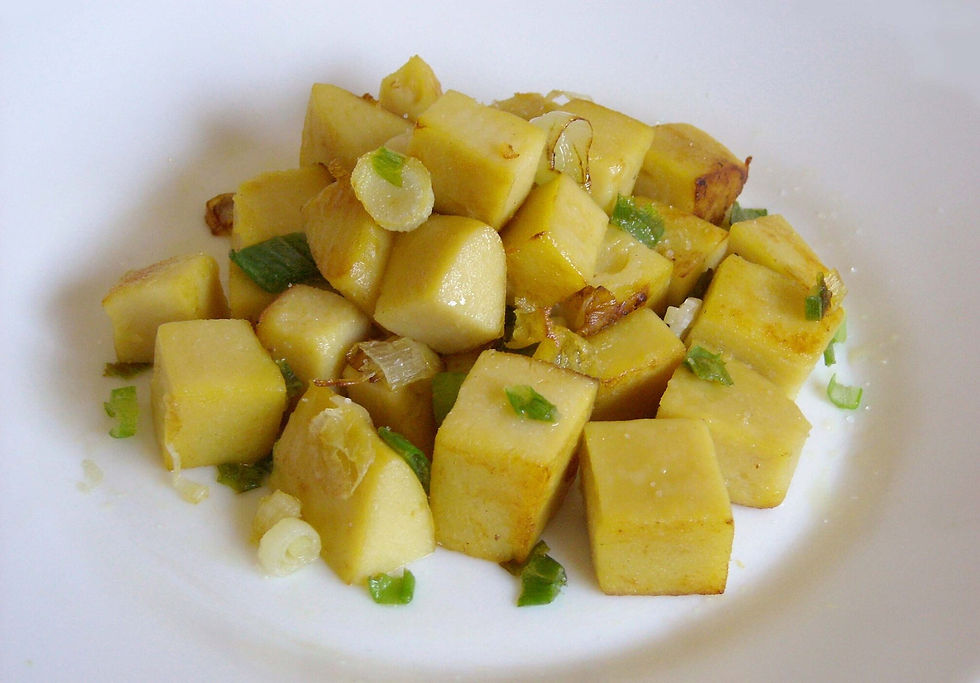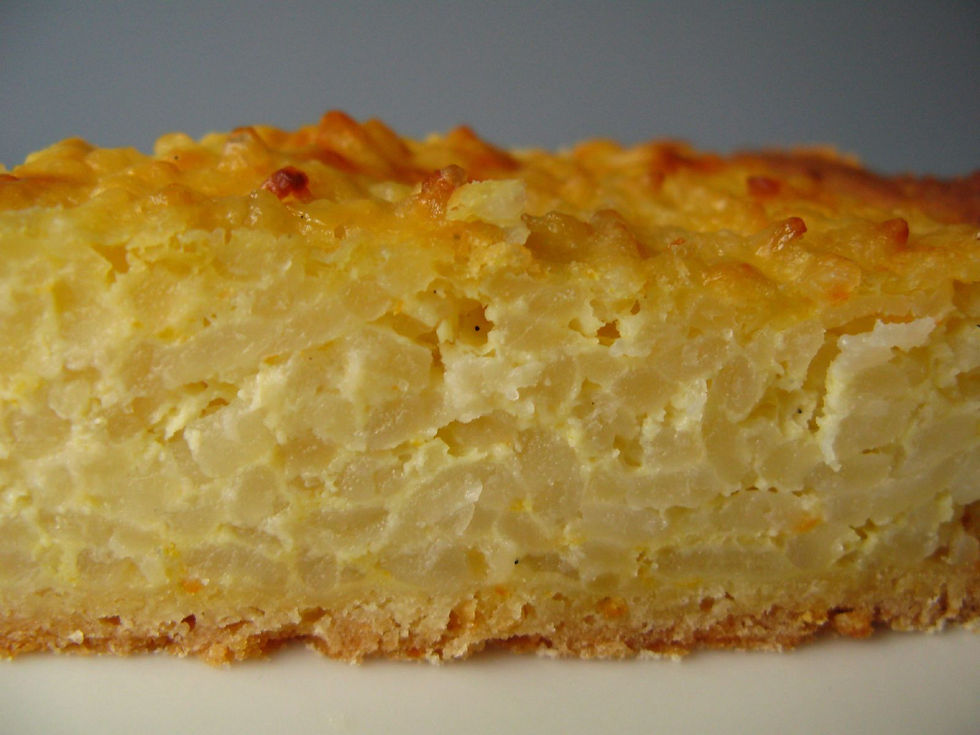Genoese Street Food: Flavours of Tradition through the Streets of Genoa
- veronicameriggi
- 19 août
- 6 min de lecture
Genoese street food has always accompanied those walking through the caruggi with tempting aromas coming from bakeries and fry shops. In the markets and along Genoa’s harbour, street food has always been part of everyday life, created for workers and people on the move. A warm slice of focaccia eaten on the go, a farinata cut into wedges, or a paper cone of fried treats say more than words about the city’s history. Street food in Genoa is not just a quick snack: it is a way of meeting tradition and stepping into the very soul of the city.
Focaccia: the Symbol of Genoese Street Food
Focaccia genovese is the starting point of any street food journey. It is a simple dough made of flour, water, oil, and salt that becomes the perfect street food thanks to its versatility.
Classic focaccia: how it is eaten “the Genoese way”
In Genoa, focaccia is not just a snack. Many locals eat it for breakfast dipped in cappuccino, a habit that surprises visitors but reflects the city’s deep bond with tradition. During the day it is found everywhere, sliced into thin strips and sold on every corner, ideal to carry while walking. The best way to enjoy it? Still warm, straight from the oven.
Variants: focaccia with onions, olives, cheese
Alongside the classic version, there are equally popular variations. Focaccia with onions is richer and more fragrant, especially popular in the markets. Focaccia with olives is a simple but tasty alternative, very common in neighbourhood bakeries. Then there is the famous cheese focaccia from Recco, thin and filled with crescenza cheese, recognised with the IGP mark and now well-known even outside Liguria.
Where to try it: historic bakeries in the caruggi
To taste real focaccia, just step into a bakery in the historic centre. In the caruggi, bakeries bake tray after tray at all hours of the day and have become must-stops for anyone seeking a quick bite. Among the best known are Panificio Mario in Via San Vincenzo and Panificio Claretta near Piazza De Ferrari, but in truth almost every neighbourhood has its own go-to bakery.

Farinata and Panissa: Chickpeas in Every Form
Among Genoese street food specialties, farinata and panissa hold a special place. Both are made from chickpea flour but become two different dishes, each perfect to eat on the go.
Farinata: the golden tray cut into wedges
Farinata is a thin chickpea flatbread baked in large copper trays. It is cut into wedges and eaten hot or cold. The texture is soft inside and slightly crisp on top. In many fry shops it is served plain with a bit of pepper, but there are also variations with onions, gorgonzola, or seasonal toppings.

Genoese panissa: served fried or in cubes
Panissa starts with the same base as farinata, but instead of being baked it is allowed to set and then cut into pieces. It can be fried into sticks and served in paper cones like chips, or cubed and dressed with oil and onions. It is one of the most popular street foods in working-class neighbourhoods and local markets.
Differences and historical curiosities
According to tradition, farinata was born by accident during a storm at sea, when a load of chickpeas and oil spilled, mixed with seawater, and created a paste that, once dried in the sun, turned into a tasty flatbread. From there the recipe spread throughout Liguria. Panissa, on the other hand, is considered the more rustic, “humble” version, often prepared at home and eaten as a quick snack.

Genoese Fry Shops: Fried Food that Tells Tradition
Genoese street food would not be the same without the friggitorie, the historic fry shops of the caruggi that for centuries have prepared paper cones full of hot, crunchy treats. Frying here is a daily ritual and one of the most authentic expressions of popular cuisine.
Friscêu and cuculli
Friscêu are small savoury fritters that can be plain or filled with salt cod, anchovies, or vegetables. They are one of the most common snacks, sold by weight and served in cones. Cuculli, by contrast, are chickpea flour fritters, crisp on the outside and soft inside, best enjoyed hot and freshly fried.
Fried milk, fried salt cod, and stuffed anchovies
Next to the fritters, there are other must-try specialties. Fried milk is a Genoese classic: a thick custard breaded and fried until golden. Fried salt cod is a legacy of the city’s seafaring past and is still often found in mixed cones. Stuffed anchovies, filled with herbs, bread, and cheese, are another typical dish perfect to eat standing or walking.
Where to try them: historic fry shops
The fry shops of Genoa’s historic centre are the best places to sample these dishes. In the alleys leading to the Porto Antico are shops that have been serving fried street food for decades. Among the most famous are Friggitoria Carega in Via di Sottoripa and Friggitoria San Giorgio in Piazza Caricamento, but many others can be found around the city. Here cones are still wrapped in yellow paper, ready to eat as you stroll

Savoury Pies
Another important chapter of Genoese street food is that of savoury pies, sold by the slice in bakeries and markets. These are simple preparations, born as homemade dishes, which over time have become perfect for eating on the go.
Torta pasqualina, rice pie and other varieties sold by the slice
The most famous is the torta pasqualina, made with thin layers of pastry filled with chard, eggs, and cheese. Originally an Easter dish, it is now available all year round. Also popular is the rice pie, dense and easy to portion, ideal to take away. Bakeries also offer pies with chard, courgettes, onions, artichokes, or pumpkin, each linked to seasonality and local produce.
How they became “street food”
Savoury pies were originally designed as main dishes for the table, but slicing them into portions turned them into one of the most practical snacks for bakery customers. In the caruggi or at the markets they are often bought alongside focaccia, wrapped in paper, and eaten without cutlery. In this way, a traditional family dish adapted to the needs of the city, becoming a true part of street food culture.

Sweet Street Food
Street food in Genoa is not limited to savoury dishes. In the bakeries and pastry shops of the centre, you can also find sweets designed to be eaten on the go, without plates or cutlery.
Cavolini
Cavolini are bite-sized choux buns filled with fresh whipped cream, a traditional Sunday treat in Genoa, available in bakeries and pastry shops. The classic version is only whipped cream, though in some pastry shops you may find variations with a thin layer of custard beneath the cream. They are filled just before serving and are perfect as a sweet snack or dessert.
Sweet fried milk
Alongside the savoury version, there is also sweet fried milk, made from a thick custard of milk, sugar, and eggs, left to set and then fried. Sprinkled with sugar, it is one of the most typical desserts from Genoese fry shops, ideal as a street snack.
Sweet fugassa and sugared frisceu
Sweet fugassa is the lesser-known sister of savoury focaccia: a soft dough enriched with sugar, traditionally made during festive occasions. Sugared frisceu, on the other hand, are fluffy fritters rolled in sugar, sold hot in fry shops or during local fairs.
Where to Find Street Food in Genoa
Genoese street food is discovered above all in the places that have animated the city’s daily life for centuries. Starting from the Hotel Astoria (discover the hotel), you can easily reach the caruggi of the historic centre, where bakeries and fry shops that shaped the city’s food culture are concentrated. In Via di Sottoripa, next to the Porto Antico, you can still find old shops preparing mixed cones of fried foods and farinata, perfect to eat while strolling. Around Piazza De Ferrari, historic bakeries bake focaccia from early morning, also enjoyed for breakfast.
Another must-see stop is the Mercato Orientale di Genova (MOG) in Via XX Settembre, where traditional stalls stand alongside modern street food counters, offering focaccia, panissa, and local sweets in a lively and central setting. Beyond the MOG, Via San Vincenzo is also worth exploring, full of shops, bars, and bakeries.
For those wanting to enjoy street food in a festive atmosphere, the city hosts events and fairs throughout the year. Among the most popular are the Cibio events, bringing food trucks and regional specialties to city squares, and the traditional festivals in Ligurian coastal towns, where fried food, farinata, and focaccia always take centre stage.
_edited.png)



Commentaires